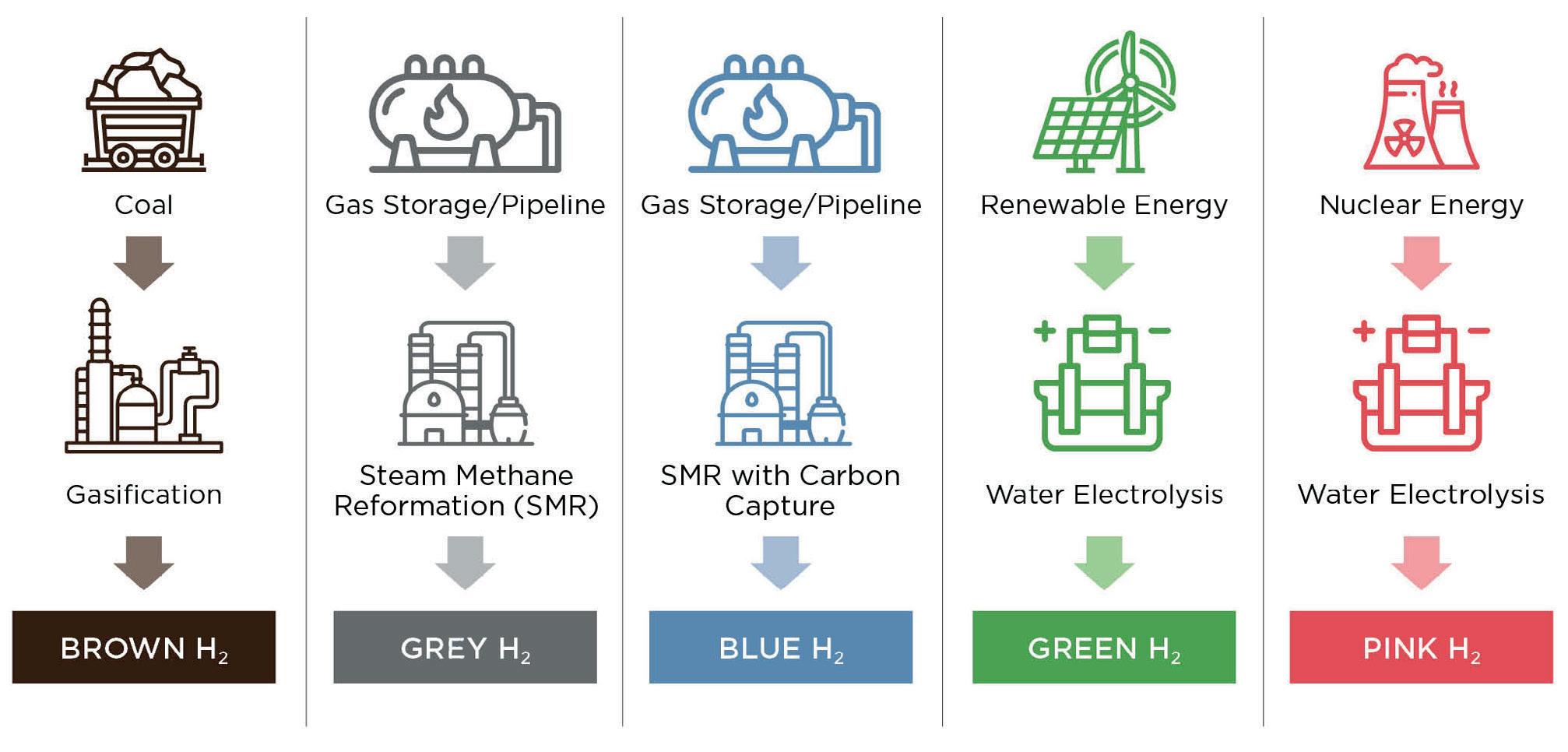
6 minute read
Green hydrogen and electrolysers: the latest state of play
As public awareness of hydrogen’s potential as a clean alternative fuel grows, the improvement of electrolysers and increased availability of cost-competitive renewable energy will be essential to the green hydrogen industry’s growth. James Abrams, American Bureau of Shipping (ABS), offers his take.
Against the backdrop of the Paris Agreement and the resulting international commitment to limit the global mean temperature rise to below 2°C (and ideally 1.5°C), the onus is now on the energy sector to find cleaner ways of generating and distributing power that are both widely accessible and commercially viable.

Figure 1. Common electrolyser designs. Left: PEM electrolyser, centre: alkaline electrolyser, right: solid oxide electrolyser (image courtesy of ABS).
Under its current administration, the US has realigned itself with the UN’s climate goals, setting a series of ambitious climate-oriented targets for 2030, including the use of 100% carbon pollution-free electricity, at least half of which will be supplied locally.
Hydrogen – traditionally used by industry as chemical feedstock – is gaining traction as a potential alternative fuel because it is an attractive proposition for energy storage, which could play a key role in future low-carbon energy systems by balancing intermittent supply with demand.
Indeed, due to its high energy density by weight, elemental abundance, and the potential to produce it at affordable costs, hydrogen is a promising option.
Central to the production of green hydrogen is water electrolysis, the process of using electricity to split water into its components, hydrogen and oxygen, using an electrolyser.
Electrolysers have a variety of configurations, but if green hydrogen is going to become a mainstream fixture in the energy mix, there are barriers to commercialisation that need to be addressed for each of them.
Alkaline, solid oxide or polymer electrolyte membrane electrolysers?
There are three common types of electrolysers, each with their own advantages and disadvantages.
Alkaline electrolysers have a long history of industry use and still represent the cheapest option to manufacture, while also having longer lifespans of up to 10 years. There are some drawbacks however, such as their large size, which makes them unsuitable for marine applications, as well as their relatively poor efficiency in comparison to other electrolyser types.
Solid oxide electrolyser cells (SOEC) require superheated steam as an input, and have an average lifespan of up to five years. They are smaller units but are currently the most expensive option to manufacture due to their high complexity and material requirements. They also have operating temperatures of as high as 1000°C, which can harm the overall efficiency of the hydrogen production process in many scenarios. However, there is potential to see them used alongside industrial processes that produce significant amounts of waste heat, such as nuclear power generation.
Industry discussions have begun to centre around polymer electrolyte membrane (PEM) electrolysers. These are smaller electrolysers that are well suited for maritime use, operate at temperatures between 50 – 80°C, and are highly responsive to load changes. Typical lifespans for PEM electrolysers are shorter, at around three to four years, and are more expensive to construct than alkaline electrolysers.
Supply chain challenges
Despite being the current leading solution in terms of viable electrolyser technology, the production of PEM electrolysers comes with the significant challenge of sourcing materials.
They contain relatively large quantities of rare earth metals such as platinum, titanium and, most critically, iridium. Mining for rare earth elements is notoriously difficult and subject to volatility of supply. Furthermore, the methods involved can produce large quantities of pollution and waste. The worldwide annual production of iridium is only 7 t, falling well short of the amounts needed to sustain the current PEM electrolyser project pipeline.
Furthermore, the role that rare earth metals play in terms of performance and durability by reducing anode corrosion cannot be easily replaced. At the moment, there is much emphasis on reducing reliance on costly or rare materials, while still improving the overall stack efficiency of electrolysers.
A developing technology similar to PEM electrolysers but with less expensive components are anion exchange membrane (AEM) electrolysers. These are showing some promise as they have the potential to be far cheaper to build and operate – however, they are not seeing much commercial development because of efficiency issues. If these challenges can be overcome, AEM electrolysers could replace PEM electrolysers as the backbone of the green hydrogen industry. AEM is still a fledgling technology though, and has yet to see serious industry use.
Access to affordable renewable energy is a greater barrier
While greater cost and performance improvements can still be made with electrolysers, it would be inaccurate to

Figure 2. Different methods of hydrogen production (image courtesy of ABS).
suggest that the future viability of green hydrogen rests solely on these developments. A greater determining factor is cost-effective access to the power needed to run them.
Green hydrogen, produced using renewable energy instead of fossil fuels, represents the gold standard in terms of emissions, but still requires significant investment and infrastructure development before it becomes cost-competitive with hydrogen produced using fossil fuels.
The numbers do not lie. Green hydrogen can cost four to eight times as much as hydrocarbon-derived hydrogen. Blue hydrogen, produced from fossil fuels with carbon capture systems, can be two to four times as expensive as grey hydrogen, which is produced using fossil fuels without carbon capture.
This underscores the strong competition that electrolysers face from other methods of hydrogen production such as coal gasification and steam methane reforming (SMR).
As a result, it is unsurprising to see that around 4% of the hydrogen produced today is green, with the remaining 96% being split across blue (around 25%) and grey (around 71%).
And because blue hydrogen, which uses carbon capture to reduce its emissions, tends to be cheaper to produce than green hydrogen, much of the focus is being placed here as a means of accelerating the energy transition.
Looking ahead
There is some optimism that green hydrogen costs will become more competitive in the future, with expectations that we will see something in the region of US$2/kg in most areas by 2030, and even US$1/kg in parts of the world with cheaper renewable energy, such as Europe. The Energy Transitions Commission is even more optimistic, forecasting that green hydrogen will become cheaper than blue hydrogen in some areas by 2030, and most of the world in 2050.
The cost of electrolysers, of course, will have a bearing on whether these forecasts ring true. Once again there are several predictions being made here, especially around alkaline electrolysers, which remain the ‘mainstream’ for now. Here, the International Energy Agency (IEA) and International Renewable Energy Agency (IRENA) indicate that prices will drop from US$950/kW to US$625 by 2030. However, for green hydrogen to become economically on par with blue and grey hydrogen, that price point needs to drop to something closer to US$125/kW.
These challenges considered, the industry is still cautiously optimistic about the direction of travel when it comes to electrolyser technology and its readiness to facilitate green hydrogen production.
ABS is currently involved in a range of projects exploring the application of hydrogen. This includes an Approval in Principle review for an offshore hydrogen production facility.
In addition to this, the company continues to offer its in-house knowledge and experience in assisting parties with risk assessments, new technology qualification, and other similar services aimed at helping clients develop and implement their own electrolysers.
There is a long way to go before green hydrogen reaches a competitive equilibrium with blue hydrogen, and the US government’s target of US$1/kg of green hydrogen by 2030 is certainly bold. There is no problem in aiming high; but it means we cannot afford to coast our way through the rest of the decade – a concerted effort involving multiple public and private stakeholders will be needed.










